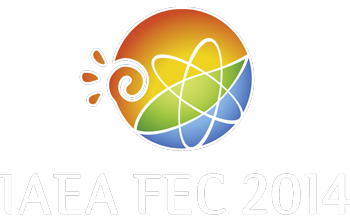Speaker
Mr
Oleksiy Mishchenko
(Germany)
Description
We give an overview of recent developments in electromagnetic simulations based on the gyrokinetic particle-in-cell codes GYGLES and EUTERPE. The code GYGLES is a linear global (full radius, full flux surface) gyrokinetic particle-in-cell code that is able to simulate up to three kinetic species (ions, electrons, fast ions). It solves the field equations for the electrostatic and parallel vector potentials. The code EUTERPE is an extension of the GYGLES code which permits nonlinear and non-axisymmetric (stellarator) simulations based on numerical (VMEC) equilibria.
Both codes have been applied to simulate Alfvenic instabilities in plasmas of fusion interest. Global Alfven Eigenmodes, Toroidal Alfven Eigenmodes (TAE), their interaction with fast particles and the Alfvenic continuum, and modification of TAE instabilities into Energetic Particle Modes (EPM) have been successfully considered with the GYGLES code. Recently, the gyrokinetic internal m = 1 kink
mode and m = 1 reconnecting mode have been simulated with GYGLES in screw pinch geometry.
The EUTERPE code contains a hierarchical collection of numerical tools of increasing complexity, including a simple perturbative scheme (CKA-EUTERPE), based on the reduced-MHD eigenvalue solver CKA; the more advanced hybrid self-consistent fluid-electron gyrokinetic-ion model; and the most comprehensive, but
also most computationally expensive, fully-gyrokinetic model. The perturbative CKA-EUTERPE tool has been implemented in stellarator geometry
(Wendelstein 7-X and HELIAS reactor) to study the interaction of fast particles with Alfven Eigenmodes. The fluid-electron gyrokinetic-ion hybrid model has been extensively used to simulate internal kink modes and fishbones in tokamak geometry. The fully-gyrokinetic electromagnetic model of the EUTERPE code has been verified using
the International Tokamak Physics Activity (ITPA) benchmark and further improvements of the cancellation scheme have been considered.
| Country or International Organisation | Germany |
|---|---|
| Paper Number | TH/P4-49 |
Author
Mr
Oleksiy Mishchenko
(Germany)
Co-authors
Dr
Allessandro Zocco
(IPP)
Dr
Axel Koenies
(IPP)
Dr
Matthias Borchardt
(IPP)
Mr
Michael Cole
(IPP)
Dr
Ralf Kleiber
(IPP)
Dr
Roman Hatzky
(IPP)
Dr
Tamas Feher
(IPP)

